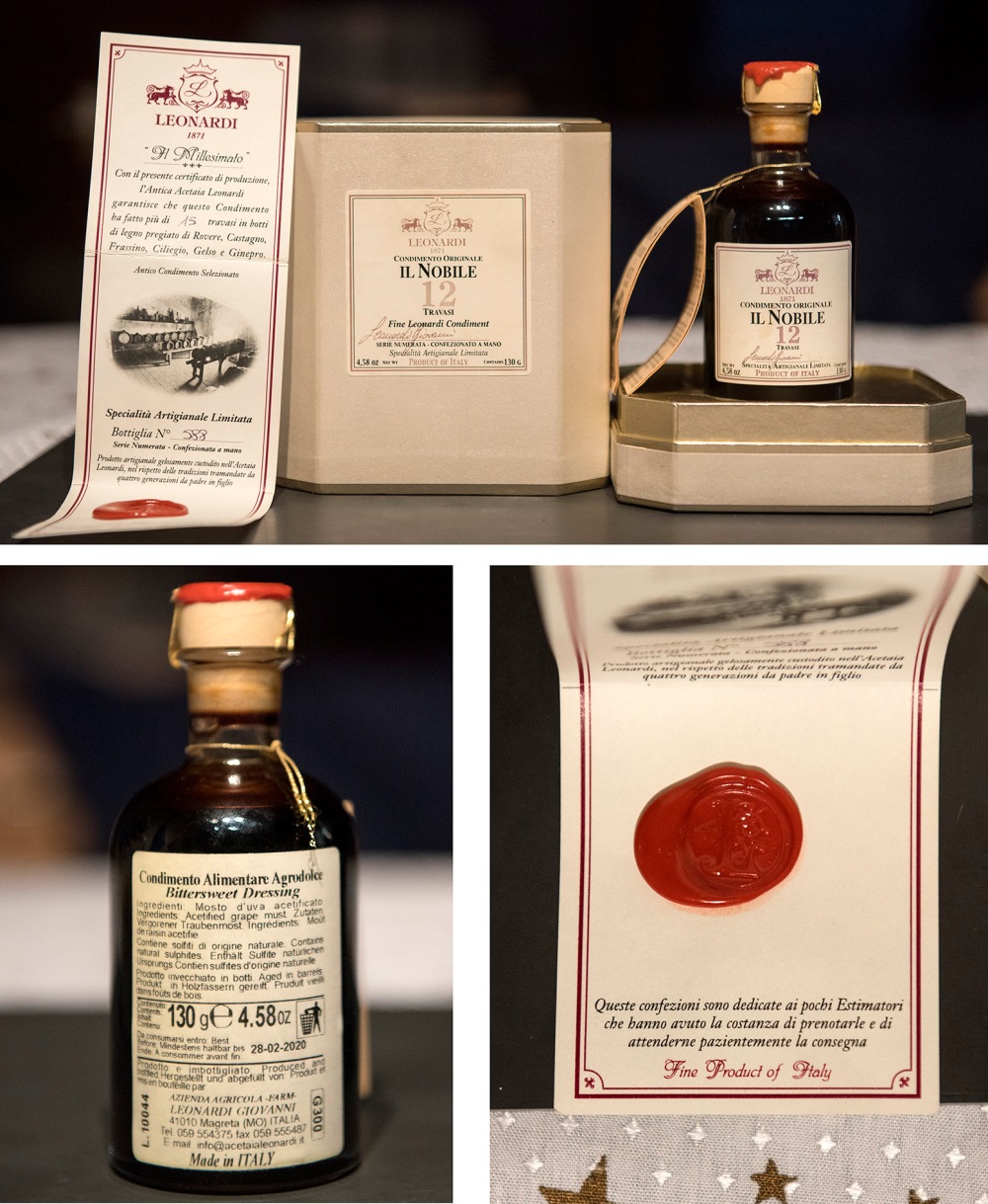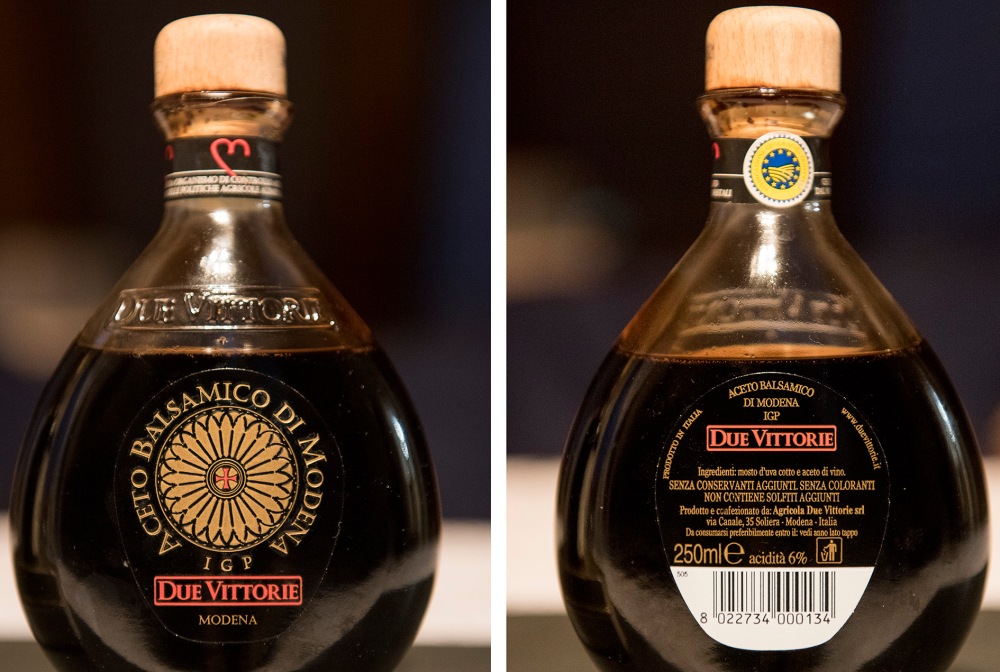This is the second post of the series “How to recognize them” 🙂 following the previous about panettone and pandoro.
On many Italian products I see that often there are not completely clear information about how they are made and what are the many differences between each of them, and sometimes some producers/sellers make profit of it selling poor quality products for higher prices.
So also this post wants to be just a help for your future shoppings 🙂
This time we are going to talk about the “balsamic vinegars”: how many types there are, how they are made, what the official procedural guidelines say and what are the indicative prices to be aware of.
I would divide soon in 3 categories: generic “balsamic vinegars” or “condimento“, Balsamic vinegar of Modena PGI (Aceto Balsamico di Modena IGP) and the Traditional Balsamic Vinegar PDO (Aceto Balsamico Tradizionale di Modena/Reggio Emilia DOP).
- generic “balsamic vinegars” or “condimento balsamico”: they are usually cheaper products, and in most of cases they are made using common wine vinegar with the addition of lower quantities of cooked must and usually caramel as a colorant, and sometimes other extra ingredients too, as concentrated must or some preservatives. But on the other hand there are also some very good products between them (a minority), which simply cannot get the PGI or PDO certificates because of some reasons (for example they are made outside of the traditional areas of Modena and Reggio Emilia, so without any consortium supervision, or they are not at least 12 years old, or they followed a slightly different aging process, etc.) but some of them are following the same/similar steps of the Traditional Balsamic vinegar and they are made exclusively with cooked must and no colorants; but in those cases you should know those producers well to know exactly what you buy. And those generic “balsamic vinegars” or “condimento” which are very good quality are not between the ones sold in supermarkets, but you can find them only in some deli shops/stores. And since there are no official standards or labeling systems to designate them, it’s almost impossible to tell their quality based only on the packaging alone. No aging time is required for these vinegars/condimenti, but those “condimento” that have been aged several years and followed very high quality standards are usually sold with authenticity certificates in which are explained the aging years, the barrels, how many pourings out, how many bottles produced, etc. and their price can be also high or very high (as high as an extra vecchio Traditional Balsamic Vinegar PDO, for the best “condimento”). Of this category I would consider only the ones made with high standards (demonstrated, of course), and personally I don’t buy the cheap ones, in that case is better to buy a normal and much cheaper wine vinegar in my opinion (which is also good for an everyday use and other uses), or to spend some few euros more for a good vinegar of the following category.
- Balsamic vinegar of Modena PGI (Aceto Balsamico di Modena IGP): this has already a Protected Geographical Indication, this is usually already a better product on the average, and there are also very good ones between those (even if usually not yet on the level of those relatively few “condimento” made by trustworthy producers with 100% must, longer aging time and certificates, but it’s a different product), and there are procedural guidelines to follow to obtain this label. But unfortunately those guidelines are not very strict, and there can be very different products labelled with the same name, at first sight. What do these guidelines say? Between other things, to be labelled with this name the product must contain at least a percentage of cooked must of 20%….this means that there can be a product with only 20% of must and 80% of common wine vinegar (lower quality), and a product with 80% of cooked must and 20% of common wine vinegar (higher quality, usually), both labelled with the same name, but they are very different in the reality 🙂 one thing to notice on the label is the order of the ingredients: if it’s written first the wine vinegar it means that there is more wine vinegar than cooked must. Moreover, the ones with lower cooked must percentages usually contains concentrated must and caramel too as a colorant (E150 the simple caramel, E150d the ammonia caramel, and it can be contained up to 2%), because common wine vinegar it’s not deep dark, while the better ones don’t need caramel to color it, this will be written on the label and it can be already a sign to notice. Unfortunately the producers are not forced to declare the exact percentages of cooked must on the label, but some of the better ones sometimes declare it on their labels. All of them has to be aged at least 2 months in wooden casks or barrels, but the ones that have been aged in wooden casks or barrels for at least 3 years long can add on their label the word “invecchiato“, which means “aged”. Their costs, in Italy, can vary from 1-2 euros/250ml to 10-12 euros/250ml, or also a bit more (few can be also over 20 euros/250 ml, usually but not necessarily those are of the “invecchiato” type). They are usually sold in 250 ml or 500 ml bottles. I would say that without any detailed specifications on the label, the price per liter can be a quality indicator. In my opinion a good bottle of these vinegar is the best choice for an everyday use, you can use it for many recipes and in many ways, and it can add a special touch.
- Traditional Balsamic Vinegar PDO (Aceto Balsamico Tradizionale di Modena/Reggio Emilia DOP): it has the Protected Designation of Origin, this is the very famous one, and of course it has specific procedural guidelines to follow (Modena type and Reggio Emilia type, basically we can say they are both the same product following almost the same standards). This is made only with cooked must, 100%, and it must be aged for a minimum time of 12 years in small wooden barrels, and over 25 years can be added on the label the definition “extra vecchio“, and it’s tasted by certified experts before being bottled. It has a history that dates back in time to several centuries, and the whole process must be made in the particular climate conditions of the attics in the old buildings where they are made, so it cannot be made in an industrial way. The must must come from grapes from specific vine varieties (Lambrusco, Ancellotta, Trebbiano, Sauvignon, Sgavetta, Berzemino, Occhio di Gatta) whose yield is limited to 16000 kg/ha. During the aging time the must will be moved yearly through the “batteria“, a series of barrels of different woods and sizes (5 to 10 barrels, of a size between 15 and 80 liters), refilling the vinegar with the same quantity of the evaporated percentage, taken from another barrel of the “batteria”, with a specific order. The different woods give to the must a lot of different aromas, and the used woods are sessile oak, chestnut, mulberry tree, juniper (these are the traditional) and cherry, ash, black locust, pear and apple (these are being used since more recent times). And the final product is very thick, much more viscous than the previous cited vinegars. The Aceto Balsamico Tradizionale di Modena DOP is allowed to be sold only in specific 100, 200 or 400 ml spherical bottles with a rectangular base (designed by the worldwide famous designer Giorgetto Giugiaro, but there are only 100 ml bottles in commerce) and there is always a serial number on it, while the Aceto Balsamico Tradizionale di Reggio Emilia DOP is allowed to be sold only in 100 or 200 ml bottles with the shape of an overturned tulip (but there are only 100 ml bottles in commerce). Their price is much higher: usually, in Italy, a 12 year old vinegar of this kind costs minimum 40/50 euro 100 ml, and products with older aging times can be very expensive, there are 25, 50, 60, 80, 100 years old vinegars, and some even older, and they can cost many hundreds of euros for a 100 ml bottle. Each bottle is sold in nice boxes, often with certificates declaring the age, in how many barrels it has been poured out, and other details. This is for special occasions 🙂
In the end I would like to mention also the Saba (or Sapa): this is more difficult to find outside the area of origin; it’s not a vinegar but a syrup obtained by boiling slowly the must, and it’s ready when only 1/3 of the original quantity remains. It’s very sweet and it was one of the ancient sweeteners. But still nowadays it is used in that area, especially next to aged cheese, but also on salads or ice creams. In the past they added to some snow, making a nice and refreshing drink. And it’s still used for “sabadoni”, a kind of sweet ravioli typical of that area. And it’s perfect also in a lemon salad.
Below you can see an example of a good quality “condimento balsamico” made by a trustworthy producer (Leonardi, who is producing also a renowned PDO/DOP traditional vinegar), paid about 35 euros/130 g, with its box and its certificate with stamp showing that it had 15 pourings out from different barrels, which woods have been used (6 different woods), which number of bottle it is, and on its label you can read that it’s made exclusively with 100% must and any colorant is added, so there are many details explained and declared, even without any PGI (IGP in italian) or PDO (DOP in italian) stamp:

In the second photo below instead you can see a good quality Balsamic vinegar of Modena PGI (Aceto Balsamico di Modena IGP), from Due Vittorie, price about 10 euros/250 ml bought in Italy, on the label you can see the PGI stamp, you can see that in the ingredients list the must comes as first ingredient, so it’s the main ingredient and not the wine vinegar, and there is no caramel as colorant, no preservatives and any added sulphites:

As you can see, the condimento made with 100% aged cooked must (as a Traditional Balsamic vinegar too) leaves a viscous and dark stain on the glass, while the Balsamic vinegar of Modena PGI (made also with a percentage of wine vinegar) doesn’t leave that stain on the glass, at least not so visible.
I hope that this post was useful and interesting to someone 🙂
I know it was long to read, but to be able to move between the many products that are apparently sold with the same/similar names and buying just the better ones avoiding a bad buy we have to know many details and we literally have to study the products 🙂 if you didn’t know these details before, at least now you can go a bit more safely and with some more knowledge to buy your good quality balsamic vinegars or to buy a good gift 🙂 and if you already knew this, then it’s always good to refresh 😉
Thank you! Now I need to go to our Italian food importer store and identify some Balsamic Vinegar 🙂
LikeLiked by 1 person
You are welcome 🙂 check every detail on the bottles, and now you can’t go wrong 🙂
LikeLiked by 1 person
Pretty enough to be wine bottles. I’m a rank beginner when it comes to balsamic vinigar. Interesting post, good information.
LikeLiked by 1 person
Thank you, I’m happy you found it useful 🙂
LikeLike